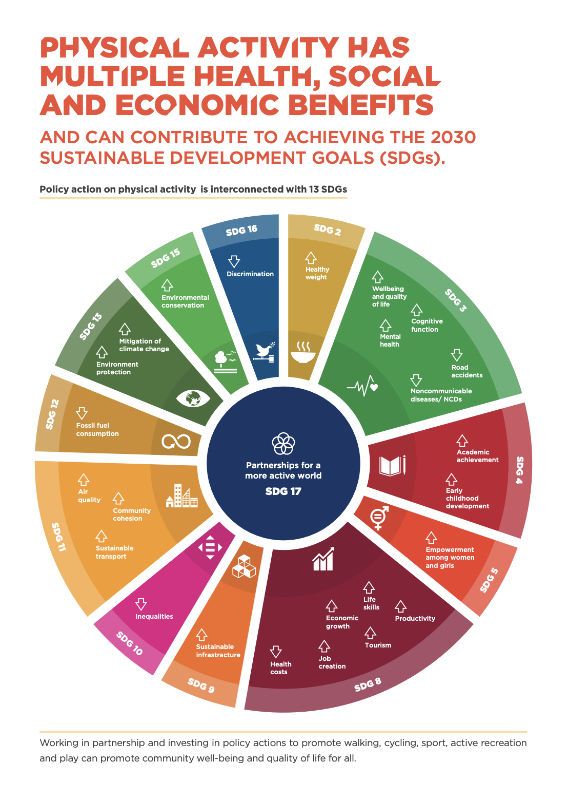The Solution (…Is You)
Ah, it is so nice to look at the colorful pamphlets and guidelines produced by various government-sponsored organizations and other experts on health and healthy living. They give us hope and somewhat structured ideas for what we all should do to stay well. Yet, while they discuss the socio-economical benefits of physical activity and try to justify their grand budgets for materials that have no significant impact on the overall problems, we are still observing the continuously increasing prevalence of all modern diseases attributed to the sedentary lifestyle.

At the same time, many of us have been discouraged by their ineffective and – let’s face it – often impractical recommendations, and we are still left on our own to deal with the issues we face. If I had a budget of the World Health Organization, perhaps I would suggest conducting a study to measure the socio-economical impact of the flawed and outdated recommendations promoted by the U.S. Department of Health and Human Services. Perhaps, one day, I will have the time and budget to do that, but, for now, we’ll stick with what's available to us and what we know; then, we can find a solution within our means and one corresponding to our needs.
What We Know
What we know now is plenty. At the very least, it should be enough to start making changes to how we approach personal health and fitness within the context of our modern, sedentary lives.
We are now aware of the Sedentary Hibernation that affects all of our internal processes without any exceptions. If we want to keep our body and brain functioning optimally throughout the day, we must intervene in the onset of sedentary hibernation with regular quick reboots.
Stay Energized and Productive
A few simple physical activities – one or two exercises every 30 minutes or so – will stimulate your blood circulation and relieve the stress from your internal organs, giving your body additional resources to utilize. Refraining from this activity and keeping your body in a sub-optimal mode can be detrimental to your health. Your productivity will also suffer, and your days will be physically exhausting, which will require a lot of time afterward to recoup. This is how we get caught up in the “cycle of constant exhaustion.”
You are tired during the day because you run your body on fumes by limiting its resources, while still expecting it to perform like a champion. When the body is chronically over-fueled by eating too much energy-dense food, you don’t feel very energized. Instead, you feel sluggish and weak. That happens perhaps because your body gets tricked into thinking that your cells are starving because of the limited resources and not due to the blood’s poor circulation. Therefore, the body may go into energy-saving mode to make sure that you have enough energy stored in case of emergency.
Let your body know that you have plenty of energy to use. Flood the cells with fresh, nutrient-enriched blood. Increase and maintain a high level of oxidative capacity of your slow-twitch muscle fibers by keeping them active.

Remember, the down-regulating mechanisms in your body usually kick in with a delay – that’s why we keep on burning extra calories, even after we are done with our workouts. After you stop running (or moving in general), your blood pressure and heart rate remain elevated for quite a while. In a similar manner, if you engage your muscles regularly throughout the day, they will remain within the highest range of energy consumption for the most part of the day because, before your body calms down and starts “hibernating,” you’ll wake it up again.
This can greatly impact your metabolic functions and help you burn some extra calories. If you introduce a steady load of low-to-moderate-intensity activities spread out around your day, it may be just enough to create that extra energy demand and to empty out some of your fat deposits. As you know, fat is a preferred energy source in these types of physical activities. You also will maintain your blood circulation at an optimal level, supplying nutrients and energy to the cells throughout your whole body. Your body will stay energized, well maintained, and free of toxic wastes, which will be eliminated by the improved and unrestricted blood circulation.
Keep Your Posture and Kinetic Chain Intact
(Avoid Unwanted Adaptations and Specializations)
Adaptations and specializations arise as a result of repetitions and physical challenges that go beyond our current physical abilities. If we do something often enough, it becomes a part of us. As we become shaped for sitting, we forget how to use our body properly because we have skewed or broken our kinetic chain, which can put us in danger.

If we accept the fact that integrated continuous movement is essential to healthy living, then we will come to understand the significance of maintaining the structural integrity of our body, as well as our ability to move properly. If, otherwise, we go against nature’s design, we will end up with a compromised, broken body, both on the inside and outside. Consequently, with all the restrictions, aches, and pains imposed by our overprotective internal “alarm” system, we may lose the internal, intrinsic motivation to move. This will further exacerbate our conditions.
It will take a lot of work, special expertise, and self-exploration to untangle and reverse this mess. Not everybody will possess the knowledge, the motivation, or the time needed to solve these multifaceted, multilayered problems. Therefore, we must be careful not to develop these unwanted adaptations and specializations. That’s why I recommend concentrating on preventive measures as a long-term strategy.
Once again, it is a sound strategy to take short breaks to release tension within the overworked and stressed structures; doing so will help us to restore and maintain proper alignment during the day. At the same time, by performing brief workouts, we can remind the body that we want to maintain the integrity of the long kinetic chain, promoting the wholesomeness of our musculoskeletal system through functional, full-body movement.
That’s right! By fragmenting your workday with quick workouts – or, rather, by fragmenting your workout and distributing it throughout your day – you’ll kill two birds with one stone, so to speak. You will boost your internal processes and prevent the structural and neurological adaptations that we ought to avoid.
But that’s not all!
Save Time
You will also save a ton of time by integrating regular exercises into your breaks.

Can you imagine walking out of your office and realizing that, not only is your work day over, but your workout for the day is also done? What a relief would that be! How much time would that save you?
Yes, in most cases, you can convert your regular gym sessions into fragmented workouts. I will describe the specially designed protocol and give you a few workout plans that you can use at the office, at home, at school – basically anywhere, even at an airport terminal or on an airplane. It’s very simple and very effective!
You will be able to train your strength, improve your flexibility, restore a functional range of motion, and add stability and balance into your movement. Depending on your work environment – for instance, if you work from home – you can also add periodic cardio challenges to stimulate your endurance and cardio-pulmonary system.
A Word on Cardio
A lot of people, especially those who are into cardio and endurance training, may believe that their workout regimens are not compatible with fragmented workouts. To them, I say: I hope you know what you are doing. A lot of people have been led to believe that chronic cardio workouts, such as long or even ultra-distance running, are the best approach to working out. I don’t agree with this notion. My position on cardio, as well as other types of training, is that everything needs to be done in moderation. There’s plenty of evidence showing that it is more than enough to go for a short jog just once a week, while maintaining a great level of cardiopulmonary function in your body. Increasing the amount of cardio training to a certain level may introduce some additional, marginal benefits, but they are not significant enough to justify the time people spent training.
My friend, this concludes the foundational introduction to the subject of responsible sedentary living. I’m happy to see that you have made it all the way to the last page of this book. That gives me hope that you were able to find what you were looking for and that I was able to deliver what I promised in the beginning – an alternative approach to healthy living without sacrificing your professional ambitions and aspirations. By adhering to the simple principles introduced along the way, you can now create a personalized plan to reactivate your body and restore your health without making drastic changes in your life.
The practical follow-up has numerous examples and templates, as well as exercise plans for you to try.
You will also greatly benefit from following me on Instagram and Facebook, where I will do my best to keep you updated and motivated. There, you’ll also have the chance to interact with other people who found my approach effective and beneficial, and who are ready to share their experience and findings with you, as well. In other words, let’s stay connected! I’m sure I will hear from you one day. For now, I wish you luck and joy as you start your lifelong journey across the calm ocean of mindful movement and healthful living!